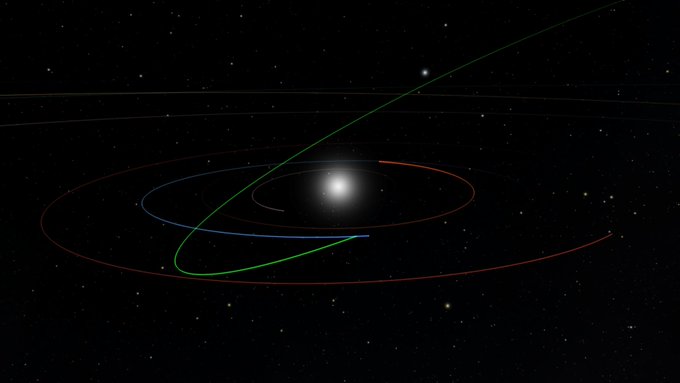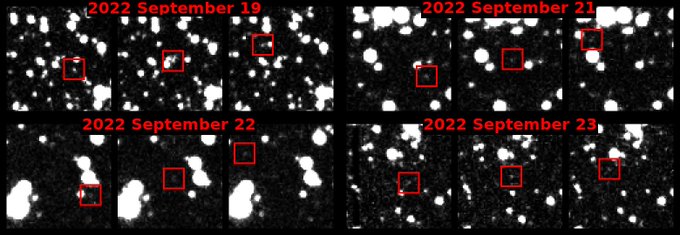We found our first potentially hazardous asteroid, 2022 SF289, using the HelioLinC3D code that will power
@VRubinObs
's LSST survey!! Written by
@uwdirac
's Ari Heinze, the new code can identify asteroids with half the observations as needed before. . 🧵 👇
6
51
147
Replies
@VRubinObs
@uwdirac
The solar system is home to millions of rocky bodies ranging from small asteroids a few feet in diameter, to dwarf planets the size of our moon. These objects remain from an era over four billion years ago, when the planets formed.
1
0
3
@VRubinObs
@uwdirac
Most of them are distant, but a number orbit close to the Earth. These are known as Near-Earth Objects (NEOs). The closest of these - whose trajectories takes them within ~5 million miles of the Earth's orbit - warrant special attention.
1
0
4
@VRubinObs
@uwdirac
The large, very nearby, objects are known as "Potentially Hazardous Asteroids" (PHAs). They're systematically searched for and monitored to ensure they won’t collide with the Earth. Such an impact would make for a /really/ bad day (or a millennium)...
1
0
4
@VRubinObs
@uwdirac
Astronomers search for PHAs using specialized telescope systems. The
@NASA
-funded
@atlas_ifa
survey, run by a team at
@UHIfA
, is a prime example.
1
0
3
@VRubinObs
@uwdirac
@NASA
@atlas_ifa
@UHIfA
To find asteroids, ATLAS takes images of parts of the sky at least four times every night. A discovery is made when they notice a point of light moving unambiguously in a straight line over the image series.
1
0
2
@VRubinObs
@uwdirac
@NASA
@atlas_ifa
@UHIfA
From its peak in the Chilean Andes, the
@VRubinObs
is set to join the asteroid hunt in early 2025. Funded primarily by the
@NSF
and the
@DOEScience
, it will be the largest optical sky survey in history of astronomy.
1
0
6
@VRubinObs
@uwdirac
@NASA
@atlas_ifa
@UHIfA
@NSF
@doescience
Rubin’s observations will dramatically increase the discovery rate of PHAs. With an 8.4-meter mirror and the massive 3,200-megapixel LSSTCam camera,
@VRubinObs
' Simonyi Survey Telescope will scan the sky unprecedentedly quickly.
1
0
2
@VRubinObs
@uwdirac
@NASA
@atlas_ifa
@UHIfA
@NSF
@doescience
To be even more efficient, it will visit spots on the sky just twice each night rather than the four times needed by present telescopes. But with this novel observing cadence, we need a new type of discovery algorithm to reliably spot space rocks.
1
0
3
@VRubinObs
@uwdirac
@NASA
@atlas_ifa
@UHIfA
@NSF
@doescience
This is where our group at
@uwdirac
comes in. Working with
@CenterForAstro
's Matthew Holman,
@UW
's Ari Heinze and Siegfried Eggl (now faculty at
@UofIllinois
) develped just such a code -- HelioLinc3D.
1
0
5
@VRubinObs
@uwdirac
@NASA
@atlas_ifa
@UHIfA
@NSF
@doescience
@CenterForAstro
@UW
@UofIllinois
The big deal about HelioLinc3D is that it can identify asteroids with much fewer (up to 50%) and more dispersed observations than required by today’s methods. It's just what
@VRubinObs
needs!
1
1
6
@VRubinObs
@uwdirac
@NASA
@atlas_ifa
@UHIfA
@NSF
@doescience
@CenterForAstro
@UW
@UofIllinois
But with Rubin still under construction, we wanted to test HelioLinc3D to see if it could discover a new asteroid in existing data. Ideally one with too few observations to be discovered by today’s conventional algorithms.
1
0
3
@VRubinObs
@uwdirac
@NASA
@atlas_ifa
@UHIfA
@NSF
@doescience
@CenterForAstro
@UW
@UofIllinois
John Tonry and Larry Denneau, lead
@atlas_ifa
astronomers, offered their observations for a test. Ari set HelioLinc3D to search through them and on July 18, 2023 it spotted its first PHA: 2022 SF289.
1
0
3
@VRubinObs
@uwdirac
@NASA
@atlas_ifa
@UHIfA
@NSF
@doescience
@CenterForAstro
@UW
@UofIllinois
In retrospect, ATLAS had observed 2022 SF289 three times on four separate nights, with a first image on September 19, 2022 at a distance of 13 million miles. But it never got the requisite four images in one night to identify it.
1
0
2
@VRubinObs
@uwdirac
@NASA
@atlas_ifa
@UHIfA
@NSF
@doescience
@CenterForAstro
@UW
@UofIllinois
These are just the occasions where HelioLinc3D excels as it only needs two images per night. Our code successfully combined fragments of data from all four nights and made the discovery.
1
0
2
@VRubinObs
@uwdirac
@NASA
@atlas_ifa
@UHIfA
@NSF
@doescience
@CenterForAstro
@UW
@UofIllinois
Other surveys had also missed 2022 SF289. Passing in front of the rich starfields of the Milky Way, it was a difficult object to catch. Now knowing where to look, additional observations from
@PanSTARRS1
and
@catalina_sky
quickly confirmed the discovery.
1
0
3
@VRubinObs
@uwdirac
@NASA
@atlas_ifa
@UHIfA
@NSF
@doescience
@CenterForAstro
@UW
@UofIllinois
@PanSTARRS1
@catalina_sky
And to complete the picture,
@moeyensj
used
@b612foundation
's Asteroid Institute's fantastic ADAM::Precovery service to uncover further unrecognized observations from the
@NSF
-supported
@ztfsurvey
telescope!
1
1
6
@VRubinObs
@uwdirac
@NASA
@atlas_ifa
@UHIfA
@NSF
@doescience
@CenterForAstro
@UW
@UofIllinois
@PanSTARRS1
@catalina_sky
@moeyensj
@b612foundation
@ztfsurvey
2022 SF289 is classified as an Apollo-type NEO. Its closest approach brings it within 140,000 miles of Earth's orbit, closer than the moon. Its diameter of 600ft is large enough to be classified as potentially hazardous.
1
1
5
@VRubinObs
@uwdirac
@NASA
@atlas_ifa
@UHIfA
@NSF
@doescience
@CenterForAstro
@UW
@UofIllinois
@PanSTARRS1
@catalina_sky
@moeyensj
@b612foundation
@ztfsurvey
Scary nomenclature aside, it poses no danger of hitting Earth for the foreseeable future. Its discovery has been announced in the
@MinorPlanetCtr
's Minor Planet Electronic Circular MPEC 2023-O26.
1
0
3
@VRubinObs
@uwdirac
@NASA
@atlas_ifa
@UHIfA
@NSF
@doescience
@CenterForAstro
@UW
@UofIllinois
@PanSTARRS1
@catalina_sky
@moeyensj
@b612foundation
@ztfsurvey
@MinorPlanetCtr
Currently, we know of 2,350 PHAs but expect there are more than 3,000 yet to be found. This is a small taste of what to expect with
@VRubinObs
in less than two years, when HelioLinc3D will be discovering an object like this every night (!!).
1
1
6
@VRubinObs
@uwdirac
@NASA
@atlas_ifa
@UHIfA
@NSF
@doescience
@CenterForAstro
@UW
@UofIllinois
@PanSTARRS1
@catalina_sky
@moeyensj
@b612foundation
@ztfsurvey
@MinorPlanetCtr
But also, it is a story the critical importance of algorithms and software in modern astronomy. From HelioLinc3D to AI-assisted codes, the codes
@uwdirac
and others are developing now power discoveries as much as new, large, telescopes.
2
0
3
@VRubinObs
@uwdirac
@NASA
@atlas_ifa
@UHIfA
@NSF
@doescience
@CenterForAstro
@UW
@UofIllinois
@PanSTARRS1
@catalina_sky
@moeyensj
@b612foundation
@ztfsurvey
@MinorPlanetCtr
To learn more, read:
HelioLinc3D:
DiRAC:
Rubin Observatory:
New algorithm ensnares its first ‘potentially hazardous’ asteroid:
1
0
5
@VRubinObs
@uwdirac
@NASA
@atlas_ifa
@UHIfA
@NSF
@doescience
@CenterForAstro
@UW
@UofIllinois
@PanSTARRS1
@catalina_sky
@moeyensj
@b612foundation
@ztfsurvey
@MinorPlanetCtr
Or view our explainer video at
0
0
5











